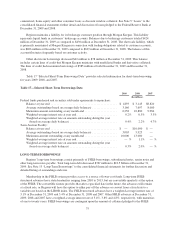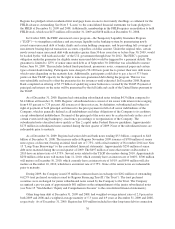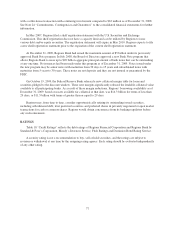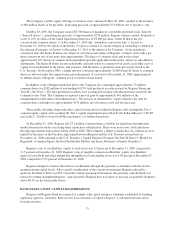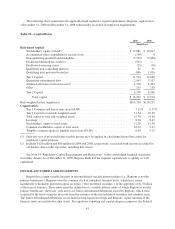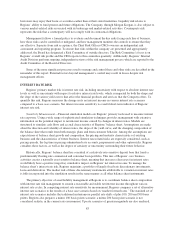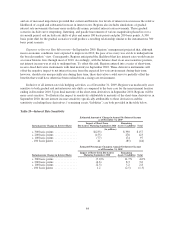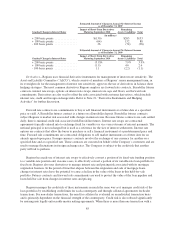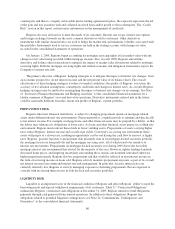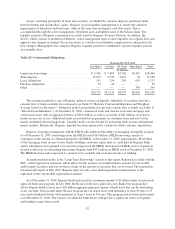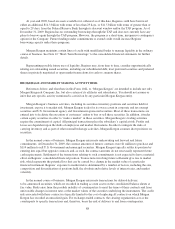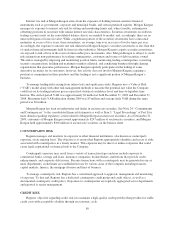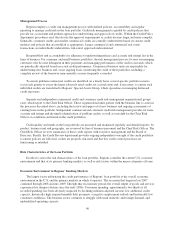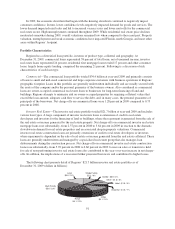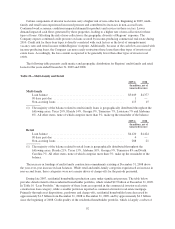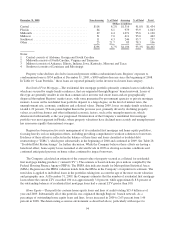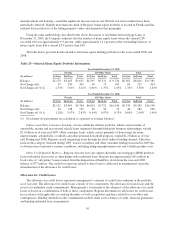Regions Bank 2009 Annual Report Download - page 99
Download and view the complete annual report
Please find page 99 of the 2009 Regions Bank annual report below. You can navigate through the pages in the report by either clicking on the pages listed below, or by using the keyword search tool below to find specific information within the annual report.
Estimated Amount of Change in Annual Net Interest Income
as of December 31, 2009
Gradual Change in Interest Rates
Impact of Short-Term Derivatives
Maturing September 2010
Remaining
Assets / Liabilities Total
(in millions)
+ 200 basis points ............... $(130) $263 $133
+ 100 basis points ............... (64) 152 88
- 100 basis points ............... 36 (74) (38)
Estimated Amount of Change in Annual Net Interest Income
as of December 31, 2009
Gradual Change in Interest Rates
Impact of Short-Term Derivatives
Maturing September 2010
Remaining
Assets / Liabilities Total
+ 200 basis points ............... (3.9)% 7.9% 3.9%
+ 100 basis points ............... (1.9) 4.6 2.6
- 100 basis points ............... 1.1 (2.2) (1.1)
Derivatives—Regions uses financial derivative instruments for management of interest rate sensitivity. The
Asset and Liability Committee (“ALCO”), which consists of members of Regions’ senior management team, in
its oversight role for the management of interest rate sensitivity, approves the use of derivatives in balance sheet
hedging strategies. The most common derivatives Regions employs are forward rate contracts, Eurodollar futures
contracts, interest rate swaps, options on interest rate swaps, interest rate caps and floors, and forward sale
commitments. Derivatives are also used to offset the risks associated with customer derivatives, which include
interest rate, credit and foreign exchange risks. Refer to Note 21, “Derivative Instruments and Hedging
Activities” for further discussion.
Forward rate contracts are commitments to buy or sell financial instruments at a future date at a specified
price or yield. A Eurodollar futures contract is a future on a Eurodollar deposit. Eurodollar futures contracts
subject Regions to market risk associated with changes in interest rates. Because futures contracts are cash settled
daily, there is minimal credit risk associated with Eurodollar futures. Interest rate swaps are contractual
agreements typically entered into to exchange fixed for variable (or vice versa) streams of interest payments. The
notional principal is not exchanged but is used as a reference for the size of interest settlements. Interest rate
options are contracts that allow the buyer to purchase or sell a financial instrument at a predetermined price and
time. Forward sale commitments are contractual obligations to sell market instruments at a future date for an
already agreed-upon price. Foreign currency contracts involve the exchange of one currency for another on a
specified date and at a specified rate. These contracts are executed on behalf of the Company’s customers and are
used to manage fluctuations in foreign exchange rates. The Company is subject to the credit risk that another
party will fail to perform.
Regions has made use of interest rate swaps to effectively convert a portion of its fixed-rate funding position
to a variable-rate position and, in some cases, to effectively convert a portion of its variable-rate loan portfolio to
fixed-rate. Regions also uses derivatives to manage interest rate and pricing risk associated with its mortgage
origination business. In the period of time that elapses between the origination and sale of mortgage loans,
changes in interest rates have the potential to cause a decline in the value of the loans in this held-for-sale
portfolio. Futures contracts and forward sale commitments are used to protect the value of the loan pipeline and
loans held for sale from changes in interest rates and pricing.
Regions manages the credit risk of these instruments in much the same way as it manages credit risk of the
loan portfolios by establishing credit limits for each counterparty and through collateral agreements for dealer
transactions. For non-dealer transactions, the need for collateral is evaluated on an individual transaction basis
and is primarily dependent on the financial strength of the counterparty. Credit risk is also reduced significantly
by entering into legally enforceable master netting agreements. When there is more than one transaction with a
85


